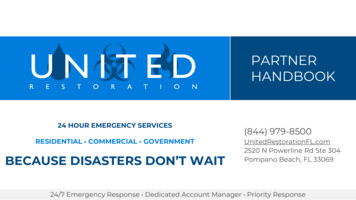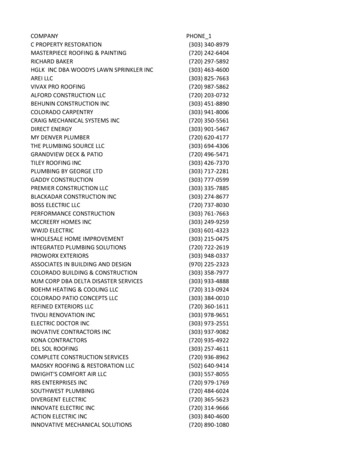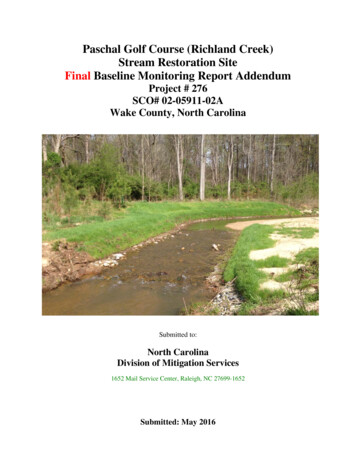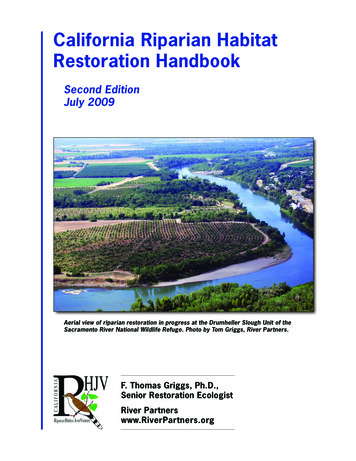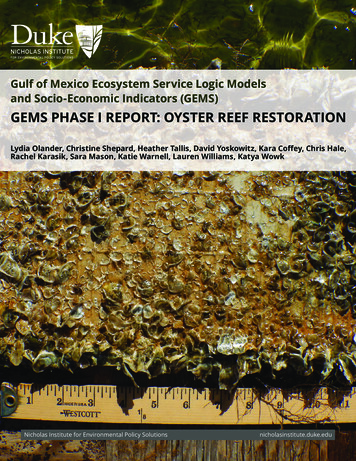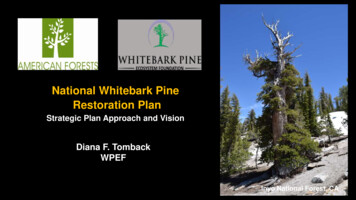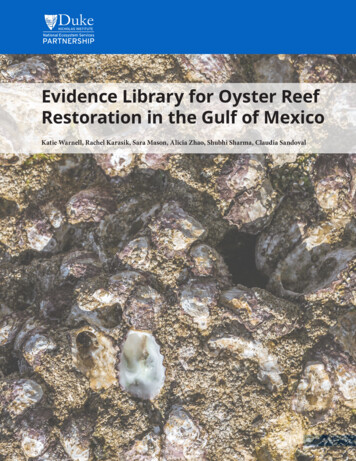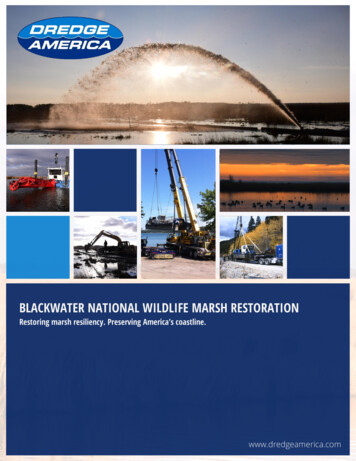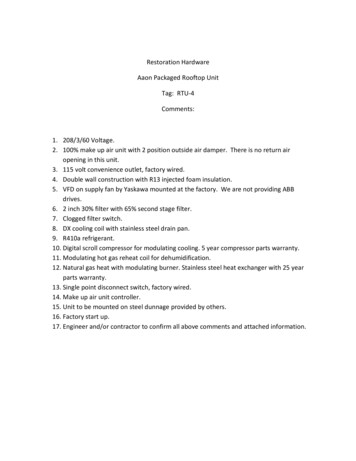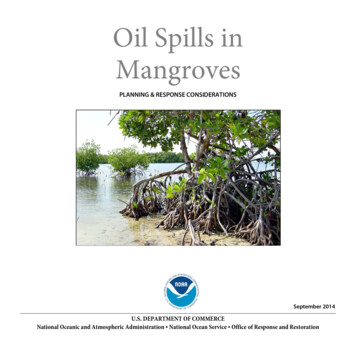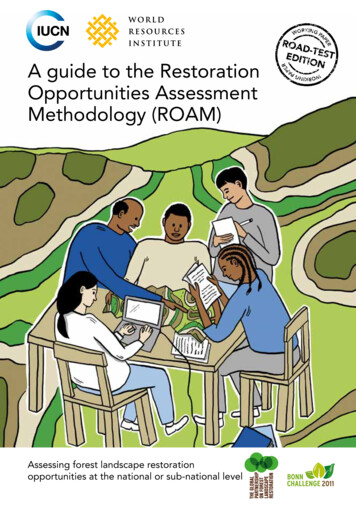
Transcription
RKINGWOPARKINGWOPAAssessing forest landscape restorationopportunities at the national or sub-national levelRPERPEA guide to the RestorationOpportunities AssessmentMethodology (ROAM)
About this handbookThis handbook has been developed to guide assessment teams through theRestoration Opportunities Assessment Methodology (ROAM), or any part of it.The handbook has been developed for three main target groups:Published by: IUCNReproduction of this publication for educational or other non-commercialpurposes is authorized without prior written permission from IUCN providedthe source is fully acknowledged.Citation: IUCN and WRI (2014). A guide to the Restoration OpportunitiesAssessment Methodology (ROAM): Assessing forest landscape restorationopportunities at the national or sub-national level. Working Paper (Road-testedition). Gland, Switzerland: IUCN. 125pp.Authors: Stewart Maginnis, Lars Laestadius, Michael Verdone, Sean DeWitt,Carole Saint-Laurent, Jennifer Rietbergen-McCracken, Daniel M. P. ShawArtwork, maps, graphics and layout: Zoï Environment Network, Geneva,SwitzerlandAvailable from:IUCN (International Union for Conservation of Nature)gpflr@iucn.orgwww.iucn.org/publications those who are commissioning an assessment, e.g. senior-level governmentofficials, who need to know what it will entail and what outputs to expect; those who are conducting an assessment, i.e. members of the core team, whoneed to know how to do it; and those who are contributing to an assessment, e.g., experts and stakeholdersat the national or regional level, who need to know what it involves.This ‘road-test’ edition of the handbook is being circulated to engage othersin the process of learning about – and improving – the methodology. A revisedversion of the handbook will be published at a later date in order to integratelearning from the road-testing process (see page 7 for more details on roadtesting ROAM).The handbook includes descriptions of the individual components of ROAMas well as guidance on how they can be combined and sequenced to suitdifferent needs. As these components continue to develop, they are evolvinginto distinct and well-defined tools. The six main components or tools of ROAMare shown below, together with the location of the current guidance on them.More detailed guidelines on these tools will be produced throughout 2014 and2015, as part of a forthcoming ‘ROAM technical series’ of publications. For moreinformation, contact us at: gpflr@iucn.orgROAM toolsStakeholder Prioritization of Restoration Interventions (see pages 58 to 63)Restoration Opportunities Mapping (see pages 68 to 83)Restoration Economic Modelling and Valuation (see pages 83 to 90)Restoration Cost-Benefit-Carbon Modelling (see pages 90 to 94)Restoration Diagnostic of Presence of Key Success Factors(see pages 94 to 98)Restoration Finance and Resourcing Analysis (see pages 98 to 105)
AcknowledgementsPrefaceThe Restoration Opportunities Assessment Methodology (ROAM) has beendeveloped through a collective and collegial learning process that has involveda large number of organizations in Ghana, Mexico and Rwanda as well as localstakeholder groups in these countries. We would like to express our gratitude to allinvolved and to our committed donors who have supported the work.Major contributors to the methodology include: in the USA the University ofMaryland; in Ghana the Centre For Remote Sensing and Geographical InformationServices, the Resource Management Support Centre of the Forestry Commission,and the Ministry of Lands and Natural Resources; in Mexico the National ForestryCommission, the National Commission for Knowledge and Use of Biodiversity,the National Commission of Natural Protected Areas and the Mexican CampesinoForest Producers Network; and in Rwanda the Rwanda Natural Resources Authorityand the Ministry of Natural Resources. Those involved in a similar nationalassessment in Guatemala, which also contributed to the methodology, includethe National Forest Institute, the Ministry of Agriculture, Livestock and Food, theMinistry of the Environment and Natural Resources and the National Council forProtected Areas.This handbook comes at an exciting time in the evolution of forest landscaperestoration (FLR). Recent developments have seen FLR become widely recognizedas an important means of not only restoring ecological integrity at scale but alsogenerating additional local-to-global benefits by boosting livelihoods, economies,food and fuel production, water security and climate change adaptation andmitigation.Preparation of the handbook has greatly benefited from the input and adviceof many colleagues and partners, including Musah Abu-Juam, James Acworth,Adewale Adeleke, Craig Beatty, Kathleen Buckingham, Chris Buss, Miguel Calmon,David Cooper, Peter Dewees, Tania Ellersick, Craig Hanson, Chetan Kumar, FosterMensah, Adrie Mukashema, Guillermo Navarro, German Obando, Orsibal Ramirez,Aaron Reuben, Katie Reytar, Estuardo Roca, Arturo Santos, Otto Simonett,Gretchen Walters and Patrick Wylie. Leslie L. Durschinger, Nora Nelson, LuzAbusaid and Cheri Sugal of Terra Global Capital provided extensive content on theanalysis of finance and resourcing options, from their forthcoming report. MatthiasBeilstein, Carolyne Daniel and Maria Libert of Zoï Environment Network provided afirst class service in the design and layout of the handbook.Special thanks for their leadership and personal contributions to this initiative aredue to H.E. Stanislas Kamanzi, Minister of Natural Resources, Rwanda and Dr.Horst Freiberg of the Federal Ministry for the Environment, Nature Conservation,Building and Nuclear Safety of Germany.Finally, we are indebted to the International Climate Initiative of the GermanMinistry of the Environment, Nature Conservation, Building and Nuclear Safety(BMUB) and the Program on Forests (PROFOR) for their generous financial supportto IUCN for the development and dissemination of the methodology and to theUK Government, whose support is making possible further development andapplication of the methodology and related tools. We are also grateful to theNorwegian Agency for Development Cooperation (NORAD) for their financialsupport for the publication of this handbook.4Road-Test EditionThe 2011 launch of the Bonn Challenge was a key milestone in this regard. TheBonn Challenge serves as an implementation platform for numerous existinginternational commitments with restoration components, with a goal to restore 150million hectares globally by 2020. As such, the Challenge seeks to catalyse earlyaction on Reducing Emissions from Deforestation and Forest Degradation (REDD )under the UN Framework Convention on Climate Change (UNFCCC) as well asaction towards achieving Aichi Biodiversity Target 15 on restoration of at least 15per cent of the world’s degraded ecosystems by 2020, and international goalsrelated to combating desertification and land degradation.The handbook has been developed by our organizations, the International Unionfor Conservation of Nature (IUCN) and the World Resources Institute (WRI), as acontribution to the Global Partnership on Forest Landscape Restoration (GPFLR)and the Bonn Challenge. It sets out the Restoration Opportunities AssessmentMethodology (ROAM) for conducting national or sub-national assessments ofFLR potential. This methodology has been developed based on pilot nationalassessments of FLR potential that have taken place in Ghana, Mexico and Rwanda.As we go to press, numerous countries are continuing, starting or planning theirown assessments. We hope that this handbook will inform those assessments and,in turn, be informed by them. The handbook will evolve and be updated. We wouldvery much like to hear from those who have conducted assessments – particularly ifthey involved adaptations or innovations to the methodology – so we may continueto share the learning. We will also be complementing the handbook with a seriesof guidance materials focused on the tools and components of ROAM. For moreinformation, please contact us at gpflr@iucn.org.Julia Marton-Lefèvre Andrew SteerDirector General, IUCNPresident and CEO, WRIRoad-Test Edition5
A ROAM application is generally undertaken by a small core assessment teamthrough collaborative engagement with other experts and stakeholders. Anational-level assessment typically requires 15-30 days of work by the assessmentteam spread over a two-to-three month period.RKINGWOPARoad-testing RoamRPEThis handbook is based on a limited number of experiences inassessing restoration opportunity in a handful of countries. Ifyou are conducting an assessment or using this handbook toguide decision-making about restoration, we want to hear fromyou. Write to us at gpflr@iucn.org to share your experiences andvisit www.iucn.org/ROAM to learn more about our on-going road-testing process.A new edition of this handbook will be available at a later date.RPEThe Restoration Opportunities Assessment Methodology (ROAM) described in thishandbook provides a flexible and affordable framework for countries to rapidlyidentify and analyse forest landscape restoration (FLR) potential and locate specificareas of opportunity at a national or sub-national level. Shared understanding of FLR opportunities and the value of multifunctionallandscapes.RKINGWOPAA rough guideto ROAM Engagement of key policy-makers and decision-makers from different sectors,as well as other stakeholders with interests in how landscapes are managed; andROAM outputsA ROAM application can deliver six main products: A shortlist of the most relevant and feasible restoration intervention typesacross the assessment area Identified priority areas for restoration Quantified costs and benefits of each intervention type Estimated values of additional carbon sequestered by these intervention types A diagnostic of the presence of key success factors and identification ofstrategies to address major policy, legal and institutional bottlenecks Analysis of the finance and resourcing options for restoration in the assessmentareaROAM can support the development of national restoration programmes andstrategies, enabling countries to define and implement pledges to the BonnChallenge target (to restore 150 million hectares worldwide by 2020) and therebymeet their existing international commitments under CBD, UNCCD and UNFCCC.Overall, ROAM can be expected to generate the following types of outcomes: Better information for improved land-use decision-making; High-level political support for FLR; Inputs for national strategies on FLR, REDD , adaptation and biodiversity,among others, and for mutually reinforcing convergence between suchstrategies; A basis for better allocation of resources within restoration programmes;6Road-Test EditionRoad-Test Edition7
Quick start guideIntroductionForest landscape restoration 15Phase 1. Preparationand planningNational and sub-nationalassessments 21Defining the problem 31Restoration OpportunitiesAssessment Methodology 23Engaging key partners 32Defining scope & outputs 3415Stratifying the area 35Identifying FLR options 38Identifying assessment criteria 4231Planning the work 46Phase 2. Data collectionand analysis55Sourcing data 64Opportunities Mapping 68Economic analysis 83Carbon analysis 90Key success factors 94Finance analysis 98Phase 3. Results torecommendations105Validating results 106Local government feedback 109Finance options 111Recommendations to implementation 1138Road-Test EditionRoad-Test Edition9
ContentsList of figures 12List of tables 13Introduction 15Forest landscape restoration 15What is forest landscape restoration?15Why restore forest landscapes?18FLR and carbon storage20FLR and biodiversity 20National and sub-national FLR assessments21Why look beyond the global level?21Restoration Opportunities Assessment Methodology23What does a ROAM application involve?26Pilot applications 26Phase 1: Preparation and planning31Defining the problem and FLR objectives31Engaging key partners 32Finding an institutional home for the assessment32Establishing the team to coordinate and lead the assessment 33Defining the outputs and scope of the assessment34Outputs 34Geographic scope 35Stratifying the assessment area 35Identifying potential FLR options 38Identifying the assessment criteria and indicators42Planning the work 46Identifying data and capacity needs46Data requirements46Capacity needs46Planning for stakeholder engagement47Organizing the inception workshop51Summary of ‘preparing and planning’ phase5210Road-Test EditionPhase 2. Data collection and analysis 55Stakeholder prioritization of restoration interventions58Data collection 64Sourcing relevant data 65Stakeholder surveys65Existing maps65Scientific literature65Specially commissioned maps66Data to inform a critical look at restoration options66Data on the costs and benefits of restoration67Restoration opportunities mapping 68Knowledge mapping approach to spatial analysis69Preparing the knowledge mapping analytical workshop 70Dividing the area into polygons71Identifying restoration options74Reviewing and revising the results74Refining and digitizing the results74Digital mapping approach to spatial analysis76Restoration economic modelling and valuation83Underlying concepts 84Estimating costs and benefits88Restoration cost-benefit-carbon modelling 90Estimation methods 90Using and reporting the estimates of carbon benefits90Conducting cost-benefit-carbon modelling91Restoration diagnostic of presence of key success factors94Restoration finance and resourcing analysis98Evaluation of potential for private investments in restoration 100Evaluating the scope for new private sector investment 100Evaluating barriers to private investment in restoration 101Evaluating private investment potential ofrestoration options 101Phase 3. Results to recommendations 105Organizing the validation workshop106Testing the perceived relevance of strategic institutional andpolicy options with local-level government 109Identifying finance options for implementing the restorationopportunities 111From recommendations to implementation 113Moving forwardFurther reading118119Appendix 1. Estimating carbon sequestration benefitsusing the IPCC Tier 1 method 122Road-Test Edition11
List of figuresList of tablesFigure 1. Wide-scale and mosaic restoration opportunities17Figure 2. Global potential for forest landscape restoration18Figure 3. Mexico’s FLR potential 22Figure 4. Simplified conceptualization of ROAM24Figure 5. Combining best knowledge and best science25Figure 6. Key steps in a typical ROAM process27Figure 7. Potential contributions of FLR interventionsto national development targets in Rwanda31Figure 8. Map showing stratification results for the Rwanda assessment36Figure 9. Typical stakeholder groups relevant to a ROAM application48Figure 10. Base map produced for the ROAM application in Ghana60Figure 11. Analysis approach as determined by data availability69Figure 12. Example of a hand-drawn polygon mapof part of an assessment area73Figure 13. Example of a quantitative output from a knowledge mapping analysis76Figure 14. Production of the Mexico assessment map,showing a few of the GIS datasets used80Figure 15. Restoration opportunities map from Guatemala assessment82Figure 16. Computing the marginal value of restoration interventions85Figure 17. Costs of landscape restoration89Figure 18. Estimated carbon sequestration potential of different FLR interventions91Figure 19. Result of cost-benefit-carbon modelling undertaken in Ghana assessment93Figure 20. Public / private financing options for FLR99Figure 21. Typology of financing strategies for restoration99Figure 22. An assessment map produced for one areaof Rwanda showing FLR intervention opportunities116Table 1.Table 2.Table 3.Table 4.Table 5.Table 6.Table 7.Table 8.Table 9.Table 10.Table 11.Table 12.Table 13.Table 14.Table 15.Table 16.Table 17.Table 18.Table 19.Table 20.Table 21.Table 22.Table 23.Table 24.Table 25.Table 26.Table 27.Table 28.12Road-Test EditionStratification results from the Rwanda assessment37The FLR options framework39Restoration options initially identified for thedifferent assessment strata in Rwanda40Some guiding questions to help direct theidentification of assessment criteria43Some examples of criteria and indicators of relevance to FLR assessments44Some of the assessment criteria and indicators defined for the Mexicoassessment 45Interests and potential roles of different stakeholder groups50Summary of parameters and questions toconsider in planning an assessment52Summary of the analytical components of ROAM56Revised listing of most appropriate FLR options, from Rwanda assessment 62List of locally adapted FLR interventions (example from Ghana)63Potentially relevant data sets for a ROAM application64Criteria for guiding the designation of polygons todifferent categories of intervention (example from Ghana)71Example of a completed polygon form75The digital mapping approach to spatial analysis77Example of reclassification of data sets andapplication of weighting systems 79Reference table for recording the results of an analysis of costs and benefit 86Cost-benefit table prepared for the Northern region of Ghana87Carbon revenue estimates for different FLR interventions in Ghana92Diagnosing the key success factors95One output of the diagnostic of key successfactors in the Rwanda assessment97Some potential barriers to private investmentin restoration in developing countries102Results of an evaluation of Rwanda’s barriersto private investment in restoration103Main points of discussion in validation workshop108Some key changes needed to improve institutionaland policy enabling conditions for restoration in Rwanda109General recommendations for attracting private investment for restoration 112Recommended finance options for some of thepriority FLR interventions in Rwanda113Strategic recommendations generated in the Rwanda assessment115Road-Test Edition13
IntroductionIf you have decided to pick up and start to read this handbook, it could very wellbe that you are already familiar with forest landscape restoration (FLR), with itspotential benefits and impact, and with the rationale for assessing FLR potentialand opportunities at the national or sub-national level. If you are, you might want toskip ahead to the next chapter. However, if any of this is relatively new to you, thisintroductory chapter aims to give you a brief explanation of the context and rationaleof FLR and the Restoration Opportunities Assessment Methodology (ROAM).Forest landscape restorationWhat is forest landscape restoration?Forest landscape restoration is the long-term process of regaining ecologicalfunctionality and enhancing human well-being across deforested or degraded forestlandscapes. It is about “forests” because it involves increasing the number and/or health of trees in an area. It is about “landscapes” because it involves entirewatersheds, jurisdictions, or even countries in which many land uses interact. It is about“restoration” because it involves bringing back the biological productivity of an areain order to achieve any number of benefits for people and the planet. It is “long-term”because it requires a multi-year vision of the ecological functions and benefits tohuman well-being that restoration will produce although tangible deliverables such asjobs, income and carbon sequestration begin to flow right away.Successful forest landscape restoration is a forward-looking and dynamic approach,focusing on strengthening the resilience of landscapes and creating future options toadjust and further optimize ecosystem goods and services as societal needs change ornew challenges arise. It integrates a number of guiding principles, including: Focus on landscapes. Consider and restore entire
through collaborative engagement with other experts and stakeholders. A national-level assessment typically requires 15-30 days of work by the assessment team spread over a two-to-three month period. ROAM can support the development of national restoration programmes and strategies, enabl
